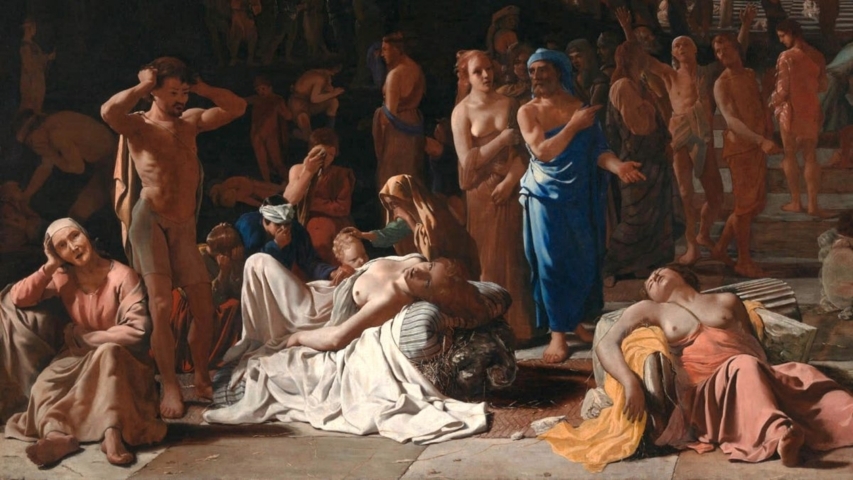6 Mysterious Disease Outbreaks That Were Never Solved
As the past year has painfully made clear, infectious diseases remain one of humanity’s greatest perils. It only took weeks for scientists to identify the cause of our ongoing pandemic—a previously unknown species of coronavirus—but there have been plenty of outbreaks, past and present, whose true cause isn’t so obvious. Here are six mysterious outbreaks that remain unsolved.
Science writer at Gizmodo and pug aficionado elsewhere
The Plague of Athens
One of the first major epidemics in recorded history is also one of its most mysterious. The Plague of Athens, which began in 430 BC and lasted for years, killed as many as 100,000 people in the ancient Greek city—around a quarter of its residents at the time. Though long thought to have been caused by plague bacteria (hence the name), that theory has since fallen out of favor. Everything from typhoid fever to an early appearance of Ebola has been tossed out as an explanation for the illness, which could cause high fevers, vomiting blood, and lesions on the skin. But no one knows for sure.
The Sweating Sickness
Near the end of the 15th century, people in England (and later Europe) suddenly began coming down with chills, headache, and pain around the limbs and shoulders. Within hours, they would break into intense episodes of sweating; within a day, as many as 50% of victims would die. The disease came to be known as sweating sickness.
Outbreaks of sweating sickness continued into the 1500s, showing up for weeks at a time in the late spring and summer. The last outbreak of the sweats was documented in 1578, after which it seemed to vanish altogether. Some theories for its cause include relapsing fever, a tickborne disease with some similar symptoms, and an unknown species of hantavirus—viruses typically spread through rats that are capable of quickly causing death.
Interestingly enough, mysterious outbreaks of sweating also showed up throughout France in the 18th and 19th century. These outbreaks were eventually blamed on a disease called Picardy sweat. But its described symptoms aren’t completely the same as the sweating sickness, and it’s not known if the two illnesses were related.
Cocoliztli
A series of epidemics throughout what’s now Mexico devastated the native Aztec population in the 16th century, killing millions every time it arrived. The outbreaks weren’t attributed to other well-known diseases at the time, such as smallpox, but came to be locally known as “cocoliztli”—roughly translated in English to “pestilence.”
Those with cocoliztli would develop symptoms like headaches, jaundice, fever, excruciating pain around their chest, and bleeding from their eyes and ears. These symptoms lend support to a theory that an unknown viral hemorrhagic fever, similar to Ebola, was the cause of cocoliztli. In 2018, though, a group of scientists unearthed another possible culprit by studying DNA left behind on the teeth of 11 victims in the area. They found a species of salmonella bacteria called Salmonella enterica. But for now, its the culprit is still being debated.
The Great Dying
In 1616, a horrific wave of illness spread throughout the Native people living in what’s now called New England. The outbreaks are thought to have wiped out as much as 90% of the population, killing thousands. Because these deaths occurred just before European pilgrims settled into the area, some colonists took it as a sign of divine providence that cleared the way for them to live there undisturbed. In truth, it’s likely that past expeditions from Europe had introduced the unknown plague to the Native populations sometime earlier, who had no preexisting immunity to it.
Potential causes for “The Great Dying,” as it’s been called, include smallpox, yellow fever, plague, and more recently, leptospirosis, a now-rare bacterial disease spread through infected animal urine or contact with contaminated food and water.
Encephalitis Lethargica
Around the time of World War I, a puzzling epidemic of neurological illness began to emerge. Between 1915 and 1928, outbreaks of this condition were documented across the world. Known medically as encephalitis lethargica, it’s also been called “sleepy sickness” (not to be confused with sleeping sickness, spread by the tsetse fly). Its symptoms included fever, seeing double, headaches, and a growing sense of drowsiness. In severe cases, people would fall into comas that they never woke up from, and survivors would often be left with lingering neurological problems.
It’s been estimated that more than a million people may have had encephalitis lethargica and that as many as 500,000 people died from it. Theories for its cause have included toxins, the direct effects of a viral infection (possibly flu) on the brain, and an auto-immune response that shows up after infection, which can be a rare complication for many known infectious diseases.
7 / 8
New Brunswick Dementia Cluster
New Brunswick Dementia Cluster
Mysterious diseases are unfortunately a reality even today. In March 2021, public health officials in New Brunswick, Canada revealed that they’ve been tracking a local cluster of people who have developed a dementia-like condition with no clear cause.
There have been 43 cases of the condition documented across people of all ages since 2015, while five people have died after their diagnosis. Symptoms include memory loss, hallucinations, and involuntary muscle movements.
Prions, the dysfunctional and transmissible proteins that build up in the brain and slowly destroy it, were considered a primary suspect at first. But the evidence collected so far, including from brain autopsies, hasn’t supported that hunch. Other going theories include toxin exposure or some other infectious agent.

